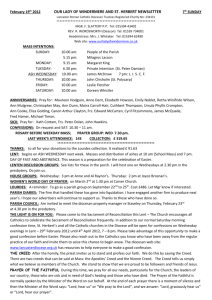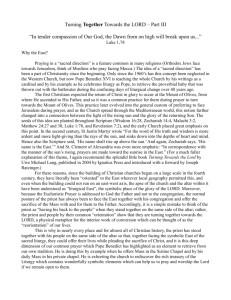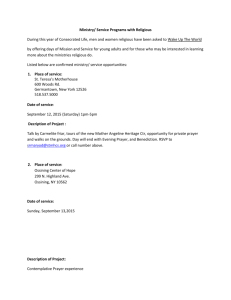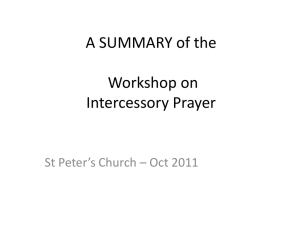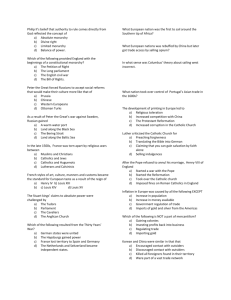Grade 8 Religion Curriculum Overview - Saint Mary
advertisement
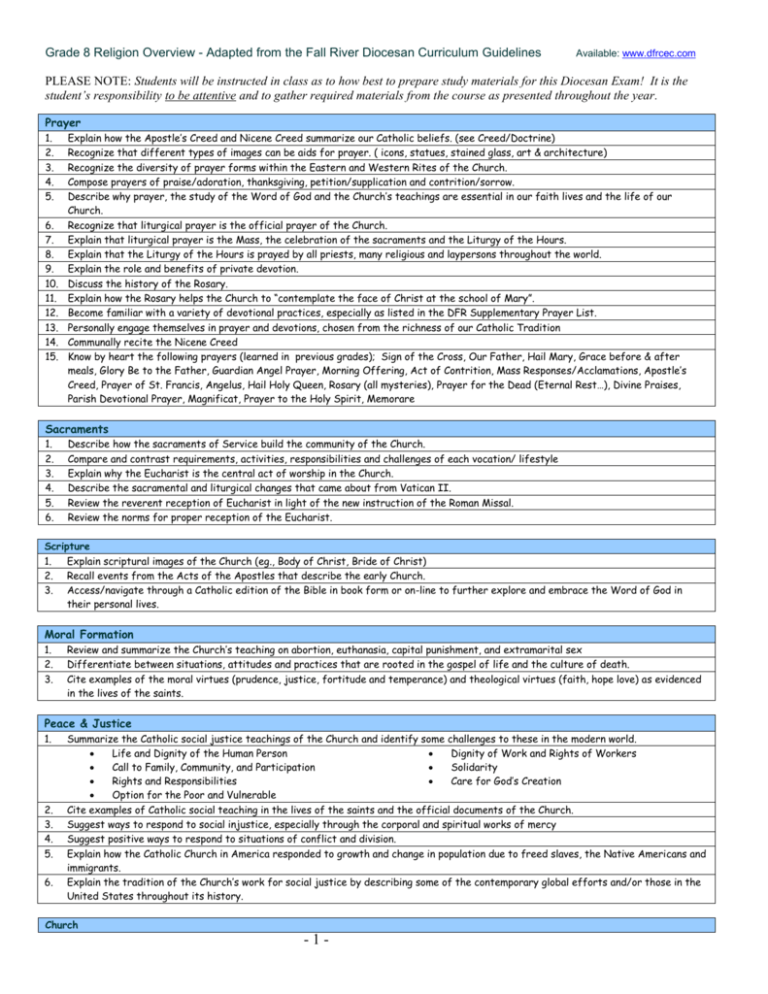
Grade 8 Religion Overview - Adapted from the Fall River Diocesan Curriculum Guidelines Available: www.dfrcec.com PLEASE NOTE: Students will be instructed in class as to how best to prepare study materials for this Diocesan Exam! It is the student’s responsibility to be attentive and to gather required materials from the course as presented throughout the year. Prayer 1. 2. 3. 4. 5. 6. 7. 8. 9. 10. 11. 12. 13. 14. 15. Explain how the Apostle’s Creed and Nicene Creed summarize our Catholic beliefs. (see Creed/Doctrine) Recognize that different types of images can be aids for prayer. ( icons, statues, stained glass, art & architecture) Recognize the diversity of prayer forms within the Eastern and Western Rites of the Church. Compose prayers of praise/adoration, thanksgiving, petition/supplication and contrition/sorrow. Describe why prayer, the study of the Word of God and the Church’s teachings are essential in our faith lives and the life of our Church. Recognize that liturgical prayer is the official prayer of the Church. Explain that liturgical prayer is the Mass, the celebration of the sacraments and the Liturgy of the Hours. Explain that the Liturgy of the Hours is prayed by all priests, many religious and laypersons throughout the world. Explain the role and benefits of private devotion. Discuss the history of the Rosary. Explain how the Rosary helps the Church to “contemplate the face of Christ at the school of Mary”. Become familiar with a variety of devotional practices, especially as listed in the DFR Supplementary Prayer List. Personally engage themselves in prayer and devotions, chosen from the richness of our Catholic Tradition Communally recite the Nicene Creed Know by heart the following prayers (learned in previous grades); Sign of the Cross, Our Father, Hail Mary, Grace before & after meals, Glory Be to the Father, Guardian Angel Prayer, Morning Offering, Act of Contrition, Mass Responses/Acclamations, Apostle’s Creed, Prayer of St. Francis, Angelus, Hail Holy Queen, Rosary (all mysteries), Prayer for the Dead (Eternal Rest…), Divine Praises, Parish Devotional Prayer, Magnificat, Prayer to the Holy Spirit, Memorare Sacraments 1. 2. 3. 4. 5. 6. Describe how the sacraments of Service build the community of the Church. Compare and contrast requirements, activities, responsibilities and challenges of each vocation/ lifestyle Explain why the Eucharist is the central act of worship in the Church. Describe the sacramental and liturgical changes that came about from Vatican II. Review the reverent reception of Eucharist in light of the new instruction of the Roman Missal. Review the norms for proper reception of the Eucharist. Scripture 1. Explain scriptural images of the Church (eg., Body of Christ, Bride of Christ) 2. Recall events from the Acts of the Apostles that describe the early Church. 3. Access/navigate through a Catholic edition of the Bible in book form or on-line to further explore and embrace the Word of God in their personal lives. Moral Formation 1. 2. 3. Review and summarize the Church’s teaching on abortion, euthanasia, capital punishment, and extramarital sex Differentiate between situations, attitudes and practices that are rooted in the gospel of life and the culture of death. Cite examples of the moral virtues (prudence, justice, fortitude and temperance) and theological virtues (faith, hope love) as evidenced in the lives of the saints. Peace & Justice 1. 2. 3. 4. 5. 6. Summarize the Catholic social justice teachings of the Church and identify some challenges to these in the modern world. Life and Dignity of the Human Person Dignity of Work and Rights of Workers Call to Family, Community, and Participation Solidarity Rights and Responsibilities Care for God’s Creation Option for the Poor and Vulnerable Cite examples of Catholic social teaching in the lives of the saints and the official documents of the Church. Suggest ways to respond to social injustice, especially through the corporal and spiritual works of mercy Suggest positive ways to respond to situations of conflict and division. Explain how the Catholic Church in America responded to growth and change in population due to freed slaves, the Native Americans and immigrants. Explain the tradition of the Church’s work for social justice by describing some of the contemporary global efforts and/or those in the United States throughout its history. Church -1- Grade 8 Religion Overview - Adapted from the Fall River Diocesan Curriculum Guidelines 1. 2. 3. 4. 5. 6. 7. 8. 9. 10. 11. 12. 13. 14. 15. 16. 17. 18. 19. 20. 21. 22. 23. 24. 25. 26. Available: www.dfrcec.com Trace the development and significant persons of the Church from Pentecost to Vatican II. Recount how the Church seeks to spread the Gospel message to every culture and age. Review that Jesus is the founder of the Church. Identify the apostles as the predecessors of our bishops. Explain the challenges faced by the early Church. Explain the major decision of the Council of Jerusalem. Explain the major contributions of the first four ecumenical councils – Nicaea, Constantinople, Ephesus, Chalcedon. Discuss how Christianity was established in the Roman Empire and the advantages and disadvantages of this. Describe the challenges to the spread of Christianity in the early Church through the Middle Ages. Explain the growth and role of monasteries from the time of the Desert Fathers through the Middle Ages. Describe how symbols, art and architecture are used to express our faith, especially in medieval cathedrals. Describe the focus and contribution of mendicant and contemplative religious communities. Analyze the history of the crusades. Describe the benefits and difficulties experienced by the Church during the Renaissance. Identify the persons and issues that brought about the Protestant Reformation. Discuss the efforts at church reform from within, the Counter Reformation and the Council of Trent. Describe the experience of Catholics in England from the reign of Henry VIII through Elizabeth I. Compare the efforts of Catholics to practice their faith with other persecutions in history and the present. Describe the history of Catholicism in America with emphasis on the history of the Diocese of Fall River. Describe the contributions and difficulties of the missions established in California and other areas of the world. Explain how the Church’s liturgy can adapt to customs and cultures (diversity), without losing its essential meaning and Church unity. Discuss the major contributions of the Second Vatican Council in bringing the Church into the modern world. Explain the hierarchical structure of the Church. Name their pastors, bishop, diocese and pope. Define Liturgy of the Eucharist /Mass as the central act of worship of the believing Catholic community. Be familiar with/access/navigate through the USCC/NCCB website and Vatican website as primary resources for Church documents and teaching Creed/Doctrine 1. 2. 3. Identify two sources of revealed Truth: Sacred Scripture and Tradition. State the precepts of the Church (CCC 2041-2046). Explain the Church’s beliefs about the Trinity (Father, Son and Holy Spirit), creation, Jesus’ humanity and divinity, the Incarnation, the Passion of Jesus, salvation, the Ascension, final judgment, the marks of the Church, one baptism, the resurrection of the dead and eternal life, as reaffirmed when we pray the Apostle’s Creed or Nicene Creed 4. Explain & give examples (from history & in current experience) of the four Marks of the Church: One, Holy, Catholic, Apostolic. 5. Recognize the role of the Holy Spirit in the formation and development of the Church. 6. Recognize that all of life is infused with the presence and power of God (grace). 7. Define the Magisterium as the moral and teaching authority of the Church. 8. Explain that the pope has the authority and responsibility to lead and guide the universal Church. 9. Be familiar with/access/navigate through the Catechism of the Catholic Church in book form or on-line as a primary resource for exploring Church teaching. Vocabulary: Identify the following people, places, terms: Acts of the Apostles Apostles Bishop George Coleman Bishop John Carroll Cathedrals Constantine Communion of the Saints Catholic Reformation/ Counter Reformation Contemplatives Council of Trent Domestic Church Ecumenical council Fall River Diocese First Vatican Council Heresy Holy Spirit Infallibility Litany Liturgy of the Hours Magisterium Martin Luther Meditation Mendicants Monasteries Moral virtues novena pilgrimage Pope Benedict XVI Pope John Paul II Pope John XXIII Pope Leo XIII Pope Pius X Protestant Reformation Roman Empire Scripture & Tradition Second Vatican Council St. Benedict St. Dominic St. Francis St. Mary of the Assumption Cathedral Theological virtues Vatican -2-


